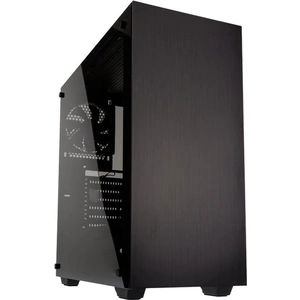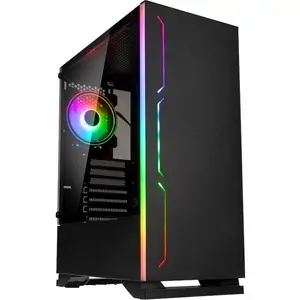Kolink Observatory RGB Tempered Glass Mid Tower Gaming Case - Black
920 ratings

TO EXPLORE MORE
Price: £63.49
Brand: Kolink
Description: Kolink Observatory RGB Tempered Glass Mid Tower Gaming Case - Black, Mid Tower, Tempered Glass Side Panel, Motherboard Support: E-ATX | ATX | Micro-ATX | Mini-ITX, Fan Support: 120mm | 140mm, Fans Included: 3x 120 mm RGB (Front) | 1x 120 mm RGB (Rear), Radiator Support: 240mm | 280mm, GPU Max Length: 380mm, OBSERVATORY RGB.
Category: Appliances and accessories
Merchant: Box.co.uk
Product ID: K88080609
Delivery time: 1
Delivery cost: 0.00
MPN: OBSERVATORY RGB
EAN: 5999094002494

Author: matt diffey
Rating: 5
Review: I don’t build many PC’s but I don’t have any complaints about this case, it’s sturdy, the RGB fans (4 included) look great with loads of colour options. There is plenty of cable management space. I have seen poor reviews about air flow and the 3 fans having a glass panel in front but there are perforated holes around this, plus a removable magnetic top filter.
Author: Luke Hughes-Bunger
Rating: 3
Review: This is a good case, especially given its price, but unfortunately has some major flaws that need to be overcome by modification, or else, will limit the performance and usability of your system. First, the good. This is a good looking case. With included RGB fans, and tempered glass, it definitely has a great modern "gaming" aesthetic, if that is something you are looking for. The styling is very much inspired by the much more expensive Corsair Crystal series of cases, and at a glance, it is really difficult to distinguish between the two. It has good space for cable routing behind the motherboard, with plenty of tie-down spaces and routing holes for clean cable management. When coupled with the large shrouded PSU basement, for extra cable storage even if you're working with a non-modular PSU, there is no reason you cannot get a very clean finish with this case, which is really important given that your system will be on show. There is space for 2x2.5" SSD's in the back of the case, and 2 3.5" drives in the basement, so there is plenty of options for keeping your drives out of the way, though, obviously, there are no 5 1/4" drive expansion bays for either DVD drives, or additional front panel IO, card readers, or controls. This is pretty much par for the course with this kind of aesthetic-focused case, but is something to consider. The case comes with three RGB case fans in the front, and one in the rear. This configuration gives the system a great look, but is slightly problematic from a cooling and airflow point of view, which we will address. The item comes with slightly tinted tempered glass front and side panels, while the top panel is steel, and is integral to the case, and the rear panel is a standard steel design, which is completely flat, rather than the bowed panels which are common in cheaper cases. The flat rear panel is nice, and gives it a much cleaner look, without compromising the cable management thanks to its generous space behind the motherboard tray, and is a welcome addition. The case comes with a fairly standard array of front panel connections, including 2x USB 2 ports, via a single USB header cable, 1x USB 3, via a USB 3 header, front panel stereo 3.5mm headphone and microphone jacks, power and reset switches, and an RGB mode selection switch. Although I referred to them as front panel headers, because of the full cover tempered glass front, they are actually located on the top of the case, which is fairly standard these days, but does limit things somewhat if you are intending to use the case in a tight vertical space. The case includes a cutout for a USB Type C port as well, but there is no internal wiring for this connection, which is a real shame, as this is fast becoming the go-to standard for many newer devices. This could theoretically be added by a relatively simple mod, but it's disappointing, though given the price, understandable that this was not included. For a standard build, focussed more on looks than performance, this is a really good case, given its price. For this kind of price point, you would be lucky to, perhaps, get a perspex window cut out of your side case panel from more well known manufacturers, so the inclusion of RGB and tempered glass is a real plus here, and creates a premium look, without the price point. The case is, for the most part, more than large enough for even enthusiast grade components, supporting motherboards up to E-ATX size (though doing do would drastically limit your cable management options) and long GPU's up to 380mm long. The case more than comfortably supported my Radeon Vega 56 Red Devil, a very large triple-slot, triple fan card, without any issues at all. However, the case is not without its flaws, which may be enough to mean this is not suitable for you. First, the big one, which others have addressed. While the case includes looks very much inspired by the Corsair Crystal series, Kolink are no Corsair when it comes to thermals. Although there are some limited air intakes along the side of the case front panel, the fans are positioned far to close to the front of the case for these to be much use at all, and the larger intake at the bottom of the case front panel is also largely obscured by the case fan shrouds. Put simply, it is starved for air intake, and, if you are planning to overclock your system, this case will significantly hamper your ability to do so, out of the box. Of course, you can run the system without the front tempered glass panel installed, which drastically improves airflow and cooling inside the case, but this adds a couple of other issues, including somewhat impacting the aesthetics of the case, as well as introducing a lot of dust into your system, since there are no dust filters on the front of the case. I initially fixed the former issue, by using some fairly lengthy standoffs to move the front panel away from the front of the case by a couple of cm, allowing for vastly improved airflow, without significantly impacting the looks of the case, but since dust remained an issue, I now run the case without the front panel at all, until I can figure out a sensible way to install a dust filter, since this gives me the best possible thermals and airflow for my system. The second issue is, that while the case claims it supports up to a 240mm radiator in the top, I was unable to get this to work comfortably with my Aorus B450 Elite motherboard and Corsair H100i Platinum RGB AIO Cooler. The problem for me was that a full size ATX motherboard is already going to be bumping up against any top-mounted fans, and once you add a radiator to the mix, it is pretty much guaranteed to begin bumping into any larger components on the top of the board. Things like the rear IO, VRM/MOSFET heatsinks, CPU Power headers and the like are all likely to get in the way if you try to top-mount the radiator and fans, meaning that, for a top mounted radiator your options is either to have the fans in a "pull" configuration outside the case, which is somewhat ugly, and causes plenty of wiring headaches, or else forcing you to be very careful with motherboard and radiator selections. For me, I ended up installing the radiator in the front. Unfortunately, although the case will happily hold three front fans, it will not support a 360mm front Radiator. This means that my only option was to install a 240mm radiator in the front, slightly off centre, reducing both my intake somewhat, and also somewhat impacting the aesthetics of the case still further. The solution works "well enough" and, with the overall aesthetic and heat improvements which come from using the H100i Platinum RGB, compared to a tower air cooler, its a more than worthwhile trade off, but is still one I would have preferred not to have to make, and would have definitely preferred to have kept 3 fans in the front. And then there are the RGB fans themselves. The fans, and the included controller are fine. They work well enough, and look good, but that's about all you can say for them. Sadly, the fan controller is basic, to say the least. It is Molex powered, and does not include a motherboard header. This means, the fans run at full speed, all the time regardless of the temperatures in the system. They are not the noisiest of fans I've ever used, but I can't say they are really quiet either, and don't move air nearly as well as fans from other, more well known manufacturers. given the airflow issues, you will definitely want to install additional exhaust fans in the top of the case. Finding compatible RGB fans is not too difficult, but, in truth, most serious users will likely quickly find themselves replacing the included fans with a better solution from other suppliers. Cheap RGB Fan kits, which include PWM fan speed control, and better, more flexible RGB control via motherboard headers, can be found for only a fraction more than the fans included in this case, and so it is a shame that Kolink didn't include a set like this instead. Given the price of the case, it is possible that they considered that it was likely to be paired with older/cheaper hardware, which did not include support for addressable RGB fans and so the stand-alone controller can almost be justified, but the lack of a PWM header, a more basic 3 pin variable voltage control header, or even a manual fan speed controller, via the included remote, is really a big oversight. If you're a gamer on a budget, looking to give your lower end build, or older rig, a sleek modern look, and are happy with the limitations of this case, then it's easy to recommend. If you're not planning to do any overclocking, and don't have a system that runs too hot, and want to add RGB and tempered glass to your system without breaking the bank. then this is very likely the case for you. But, if you're a more serious user, or system builder, then even given the price, this one has enough reasons to, at minimum cause you to take a long hard look at it. If you're planning to overclock the system, you're going to need to address the airflow issues, and are likely looking at water cooling. By the time you have modded this case to improve airflow added dust filtering to the front panel, added more effective and better supported RGB fans and LED strips, you're going to have likely spent enough extra on this case to, that you'll be in a similar price range to RGB Tempered glass offerings from the likes of Phanteks and Aerocool, which are unlikely to have anywhere near the idiosyncrasies of this case, and you are not too far from being within reach of the price point for entry-level tempered glass and RGB offerings from companies like Corsair, Cooler Master, Fractal Designs and NZXT, which may be worth saving up, and paying extra for. On the whole, I'm still happy with the purchase. I still have a case which looks much more expensive than it is, and meets my needs, which even with some add-on purchases, cost me a lot less than the Corsair cases it i














